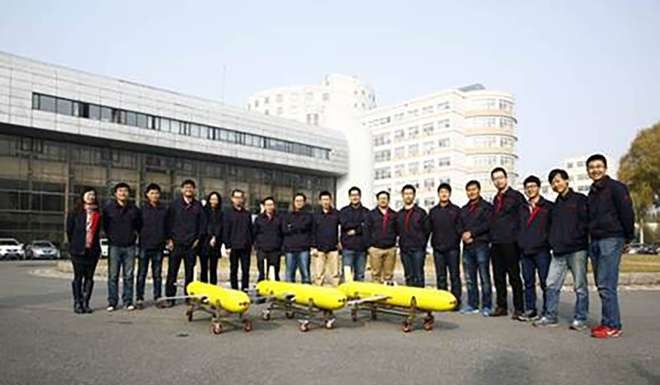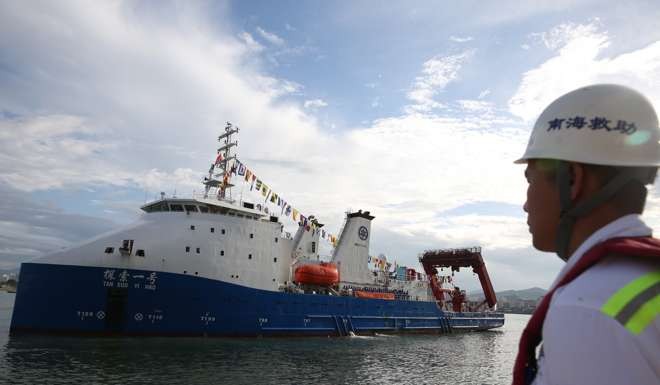 |
| A fleet of underwater glider Haiyi developed by professor Yu Jiancheng’s team at the Shenyang Institute of Automation, Chinese Academy of Sciences. Photo: Chinese Academy of Sciences |
 |
| A test run of an early version of the Haiyi in 2011, carried out in the western Pacific Ocean |
The Haiyi-7000. It was able to glide down to a depth of 5,751 metres.
“We could have gone deeper, but we did not want to push it to the limit
too early,” said Professor Yu Jiancheng, the lead scientist of the Haiyi
project.
The present record depth for underwater gliding
is 6,000 metres, set by the vessel Seaglider, developed by researchers
at the University of Washington.
Scarlet, another submersible glider developed at
Rutgers University, in the United States, made history as the first
robot to swim across the Atlantic Ocean in 2009.
Both gliders were now being used by the US Navy.
Haiyi, in Chinese, means “sea wings”. The
underwater vessel is shaped like of a yellow torpedo with a pair of
wings; its number denotes the maximum depth in metres to which it could
dive.
To travel so far underwater, Haiyi needs to shrink in size to increase its density.
The vessel then inflates to increase its buoyancy in order to move upwards.
During each rise and fall, Haiyi’s wings drive the vehicle to move forwards, the same way that a glider travels through the air.
The vessel’s deflation and inflation is controlled by a balloon-like device filled with pressurised oil.

A submersible glider works by drawing free power from the natural buoyance of water to move around without an engine or motor.
It can cruise noiselessly beneath the surface of
an entire ocean without human intervention for days, months, or a year –
all the while collecting data for scientific research and monitoring
environment in vast areas.
When necessary,an underwater glider could also switch into action against a designated target, such as submarine.
It can be let loose individually, or as part of a group of hundreds like a pack of wolves roaming over a steppe for prey.
China’s underwater glider experiment was carried
out on board Tansuo-1, the academy’s new 94-metre long ship, which is
part of China’s rapidly expanding scientific research fleet.
The ship completed its first voyage – returning
to harbour in Sanya on August 12 – after carrying other advanced
deep-sea exploration equipment developed by Chinese researchers.
It also transported a deep-sea robot, called
Haidou, which is able to operate below a depth of 10,000 metres while
collecting mineral and marine life samples on the world’s deepest sea
beds.
Yu said the test run of Haiyi went surprisingly well.

“Going deep turned out to be easier than we previously thought,” he said.
“In very deep water you don’t need to worry about sharks or fish nets. It’s really peaceful and quiet down there.”
Yu’s team was one of a number of research groups in China that have been developing underwater glider technology.
Other gliders included the Haiyan, which was
developed by researchers at Tianjin University, and several classified
models that are currently being tested by the PLA Navy.
Yu’s work started years ago, but up until 2014
the maximum depth achieved by Haiyi and other Chinese underwater gliders
was no greater than 1,500 metres.
To go deeper underwater, the scientists had to
overcome the challenge of building a glider using a lightweight material
that was also extremely strong so that it could withstand tremendous
pressures. Only a handful of nations are able to develop such
technologies.
The Chinese researchers were also working under a
time pressure because of demand to create deep-sea exploration vehicles
from the government.
In recent years, the nation had significantly
increased its scientific activities in the oceans, where much of the
world’s untapped energy and mineral resources can be found.
The demand for such vehicles was also to meet military requirements.
The relatively simple sensors on the current
version of Haiyi were able to measure the temperature and salinity of
sea water at various depth, but this information was also of interest to
the PLA as valuable intelligence, Yu said.
“The military can use the temperature and
salt-level data from the deep to build a complete, precise model of the
physical ocean,” Yu said.

Underwater glider – challenging the record held by a vessel now in use by the US Navy.
“The model will help submarines to avoid
dangerous areas and predict the occurrence of deathtrap currents, which
might jeopardise a naval operation.”
Yu refused to confirm when and whether the Haiyi-7000 would serve the PLA Navy.
According to an article on the website of the
Chinese Academy of Sciences, a 1,000-metre version of Haiyi has already
been deployed in the western areas of the South China Sea, where China
and Vietnam have territorial disputes.
At the moment, the cost of an underwater glider
was about 100 million yuan (HK$116 million) on the international market,
but Yu said he expected the price would drop sharply once mass
production started.
With improved technology, the vessel would also
be able to carry a greater variety of sensors – perhaps even weapons
with the capability of damaging or destroying a military target.
“An underwater glider comes with a structure that is much less sophisticated than that of a car,” Yu said.
“A small car in China can be sold for only
30,000 to 40,000 yuan. I think the glider won’t be more expensive than
that if the annual production runs to hundreds of thousands,” he said.
Yu declined to reveal more technical details
about Haiyi, such as how long it could operate after being deployment
and how far it could travel.
The glider carries a high-density lithium
battery, which provides energy for its sensors. It also needs power when
beaming data to satellites.
“We are aiming for something that can cross the Pacific Ocean,” Yu said. SCMP

Post a Comment Blogger Facebook Disqus